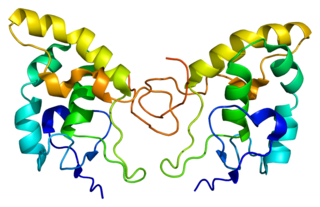
Probable G-protein coupled receptor 88 is a protein that in humans is encoded by the GPR88 gene.

G-protein coupled receptor 183 also known as Epstein-Barr virus-induced G-protein coupled receptor 2 (EBI2) is a protein that in humans is encoded by the GPR183 gene.

G protein-coupled receptor 1, also known as GPR1, is a protein that in humans is encoded by the GPR1 gene.

G protein-coupled receptor 6, also known as GPR6, is a protein which in humans is encoded by the GPR6 gene.

Neuropeptides B/W receptor 2, also known as NPBW2, is a human protein encoded by the NPBWR2 gene.

Probable G-protein coupled receptor 34 is a protein that in humans is encoded by the GPR34 gene.

Free fatty acid receptor 3 (FFA3) is a G-protein coupled receptor that in humans is encoded by the FFAR3 gene.

Frizzled-5 is a protein that in humans is encoded by the FZD5 gene.

Frizzled-3 is a protein that in humans is encoded by the FZD3 gene.

Frizzled-6 is a protein that in humans is encoded by the FZD6 gene.

Frizzled-7 is a protein that in humans is encoded by the FZD7 gene.

Frizzled-8 is a protein that in humans is encoded by the FZD8 gene.

Probable G-protein coupled receptor 124 is a protein that in humans is encoded by the GPR124 gene. It is a member of the adhesion-GPCR family of receptors. Family members are characterized by an extended extracellular region with a variable number of protein domains coupled to a TM7 domain via a domain known as the GPCR-Autoproteolysis INducing (GAIN) domain.

G-protein coupled receptor family C group 5 member C is a protein that in humans is encoded by the GPRC5C gene.

Leucine-rich repeat-containing G-protein coupled receptor 5 (LGR5) also known as G-protein coupled receptor 49 (GPR49) or G-protein coupled receptor 67 (GPR67) is a protein that in humans is encoded by the LGR5 gene. It is a member of GPCR class A receptor proteins. R-spondin proteins are the biological ligands of LGR5. LGR5 is expressed across a diverse range of tissue such as in the muscle, placenta, spinal cord and brain and particularly as a biomarker of adult stem cells in certain tissues.

Secreted frizzled-related protein 2 is a protein that in humans is encoded by the SFRP2 gene. This gene encodes a member of the SFRP family that contains a cysteine-rich domain homologous to the putative Wnt-binding site of Frizzled proteins. SFRPs act as soluble modulators of Wnt signaling. Methylation of this gene is a potential marker for the presence of colorectal cancer.

Interleukin 21 receptor is a type I cytokine receptor. IL21R is its human gene.

Porimin is a protein that in humans is encoded by the TMEM123 gene.

Protein GPR89 is a protein that in humans is encoded by the GPR89B gene.

Transmembrane protein 59 is a protein that in humans is encoded by the TMEM59 gene.


















